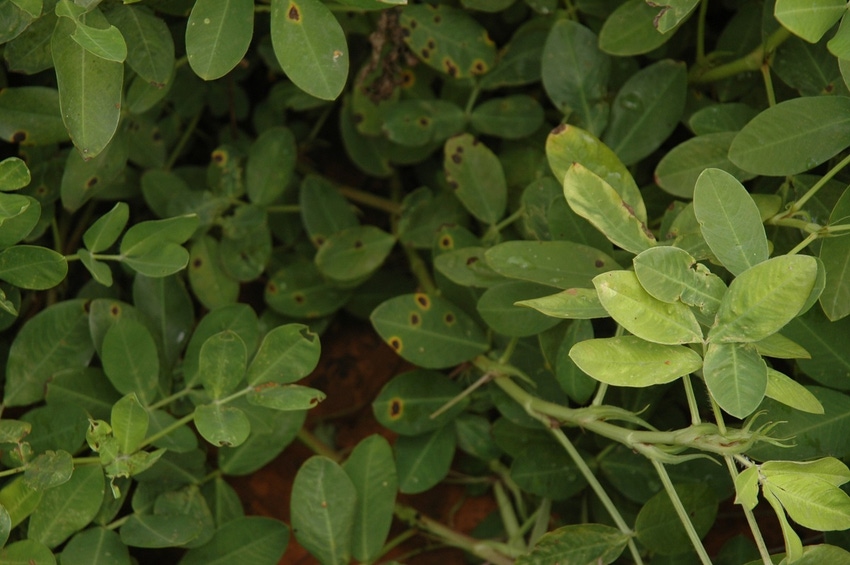
Variety selection, rotation, field history, and fungicide applications play important roles in controlling foliar and soilborne diseases in Oklahoma peanuts, and with depressed commodity markets, the challenge is choosing the right variety, maintaining a proper rotation, and developing an efficient, economical, and effective fungicide program.
“Variety selection is the first decision,” says Oklahoma State University Extension Plant Pathologist John Damicone, who spoke at the recent Oklahoma Peanut Expo at Altus. “But, it has become a lot harder for growers to get the seed they want; they’ve had to plant a lot of varieties from the Southeast lately.”
Market type selected also influences disease control decisions, he says. “Spanish peanuts have less disease pressure, but we get higher yields with Virginias. Growers have to look at the numbers. We’d like to choose varieties that are not as susceptible to disease pressure, but we can’t always get what we want from the shellers.”
Improved genetics and a good arsenal of fungicides provide economic solutions to peanut disease issues, Damicone says. With a disease such as Sclerotinia, producers see a significant advantage from fungicide applications. “We see from 1,000 pounds to 1,500 pounds per acre advantage with fungicide use.”
A more resistant variety may reduce the need for fungicide application, he says. Lariat, a new runner variety released this year by Kelly Chamberlin’s USDA-ARS lab at Stillwater, shows no yield advantage from fungicide application, but yields are comparable to market standard varieties. “We hope to get it in growers’ hands soon, so they can plant a variety with no need for a fungicide for Sclerotinia blight,” Damicone says.
For the latest on southwest agriculture, please check out Southwest Farm Press Daily and receive the latest news right to your inbox.
SITE SELECTION CRITICAL
Site selection is a critical factor in managing soil borne diseases and nematodes, he notes. “We recommend a two year to three year rotation to a non-legume crop, and judicious use of fungicides and nematicides.” A new product from Bayer CropScience, Velum, shows promise for controlling nematodes, he says.
Two nematode species affect Oklahoma peanuts, the peanut root knot nematode and the northern root knot nematode. The peanut root knot nematode kills the plant, while the northern strain stunts plants. “Producers should pull samples and send them to the OSU lab for analysis,” he says. “Currently, there is no charge for the service.”
He recommends that farmers start checking for soilborne diseases at mid-season. “Field history is important.” Producers should note where they have had incidences of soilborne diseases.
“We see pod rot problems on Virginia peanuts, Pythium or Rhizoctonia, which can be serious.”
Abound and Ridomil have been the main fungicide recommendations.
Calcium application, a typical treatment in the Southeast to prevent pod rot, has not been effective in the Southwest, even at high rates, Damicone says. “At more than 1,000 pounds per acre, calcium doesn’t help for pod rot here. Variety selection makes a huge difference. Year-in and year-out, we see more problems in Virginia peanuts.” Limb rot, he says, is not often identified in Oklahoma peanuts, he says.
SCLEROTINIA PROBLEMS
Sclerotinia can be troublesome and expensive to control, he says. “Farmers who have it, know it. Symptoms include a white stem. The disease will take peanuts off the infected plant.” Omega and Endura are the most effective fungicides, while Fontelis and Propulse are rated fair. “We see a yield response to all four products —about $100 worth of peanuts.”
Foliar diseases also may take a toll on Oklahoma peanuts. “Texas growers don’t see foliar disease as much,” he says, “but we may have to treat for early and late leaf spot. Sometimes we have both in the same season.”
Late leaf spot is more aggressive, but early leaf spot is more common. “We see some web blotch, too, so watch for that in September on Spanish varieties.”
Foliar diseases can cause serious yield loss, Damicone says. “You don’t want to see stems when you look at the canopy. If you’re losing leaves from the canopy, you’re losing peanuts.”
Control may require from three to six fungicide applications. Also, Spanish peanuts are more vulnerable to leaf spot damage, compared to Virginias and runners, where it’s possible to reduce spray applications from five to three. A reduced calendar spray program keeps fungicide applications closer to three.
Control is essential, he says. “To make high yields, you have to control leaf spot.” The disease is not curable once it’s established, he notes. Treatments are preventive, and are similar to coating a surface with paint to protect it from infection. Fungicides last about 14 days.
A Mesonet peanut disease advisory also can help producers establish an economical system of control. The program advises when the disease is likely to infect peanuts, and sends alerts for preventive spray applications.
Several fungicides are available to control leaf spot, Damicone says. They include Bravo, Tilt, Headline, and Stratego. “Headline is very effective on leaf spot,” he says. “Good, economical fungicides are available.”
About the Author(s)
You May Also Like






